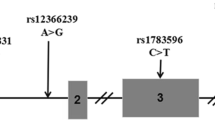Abstract
Background: Protein tyrosine phosphatase (PTP)-1B, encoded by the PTPN1 gene, negatively regulates insulin signaling by dephosphorylating the phosphotyrosine residues of the insulin receptor kinase activation segment. Several rare single nucleotide polymorphisms (SNP) have been linked to diseases accompanying insulin resistance such as Type 2 diabetes, obesity, and dyslipidemia in different populations. Aim: To investigate whether PTP-1B SNP are associated with hypertension and hypertension-related metabolic traits in Chinese subjects. Materials and methods: A total of 239 Chinese patients with hypertension and 141 non-hypertensive subjects were screened. The genotypes of PTP-1B gene polymorphisms were determined by PCR-restriction fragment length polymorphism methods. Results: The case-control study showed associations between the frequencies of T allelic g54281 T>A and A allele of I5/37C>A and hypertension (p<0.0001, p=0.0371, respectively). In addition, significant associations were observed between the IVS6+G82A polymorphism and waist circumference, total cholesterol, and LDL-cholesterol levels in hypertensive patients (p=0.0005∼0.0260). And g54281 T allele was associated with higher plasma triglyceride (p=0.0390) and LDL-cholesterol concentration (p=0.0141), while g58585 T>C was associated with body mass index (BMI) (p=0.0308), waist circumference (p=0.0216), and homeostasis model assessment of insulin resistance (p=0.047). Multivariate logistic regression analysis showed that T allele carriers of g54281T>A and A allele carriers of I5/37C>A had higher risks of hypertension independent of age, gender, BMI, glucose levels, and lipids profiles [odds ratio (OR): 1.79, 95% confidence interval (CI): 1.09–2.96, p=0.02; OR: 1.66, 95% CI: 1.13–2.44, p=0.01, respectively]. Conclusions: PTP-1B polymorphisms contribute to pathogenesis of hypertension in Chinese subjects and PTP-1B SNP may be involved in the development of several features including dyslipidemia and obesity in hypertensive subjects.
Similar content being viewed by others
References
Reaven G. Metabolic syndrome: pathophysiology and implications for management of cardiovascular disease. Circulation 2002, 106: 286–8.
Groop L. Genetics of the metabolic syndrome. Br J Nutr 2000, 83 (Suppl 1): S39–48.
Klaman LD, Boss O, Peroni OD, et al. Increased energy expenditure, decreased adiposity, and tissue-specific insulin sensitivity in protein-tyrosine phosphatase 1B-deficient mice. Mol Cell Biol 2000, 20: 5479–89.
Santaniemi M, Ukkola O, Kesäniemi YA. Tyrosine phosphatase 1B and leptin receptor genes and their interaction in type 2 diabetes. J Intern Med 2004, 256: 48–55.
Echwald SM, Bach H, Vestergaard H, et al. A P387L variant in protein tyrosine phosphatase-1B (PTP-1B) is associated with type 2 diabetes and impaired serine phosphorylation of FTP-1B in vitro. Diabetes 2002, 51: 1–6.
Gouni-Berthold I, Giannakidou E, Muller-Wieland D, et al. The Pro387Leu variant of protein tyrosine phosphatase-1B was not associated with diabetes mellitus type 2 in a German population. J Intern Med 2005, 257: 272–80.
Kipfer-Coudreau S, Eberlé D, Sahbatou M, et al. Single nucleotide polymorphisms of protein tyrosine phosphatase 1B gene are associated with obesity in morbidly obese French subjects. Diabetologia 2004, 47: 1278–84.
Olivier M, Hsiung CA, Chuang LM, et al. Single nucleotide polymorphisms in protein tyrosine phosphatase 1B are associated with essential hypertension and obesity. Hum Mol Genet, 2004 13: 1885–92.
Di Paola R, Frittitta L, Miscio G, et al. A variation in 3′UTR of hPTP1B increases specific gene expression and associates with insulin resistance. Am J Hum Genet 2002, 70: 806–12.
Matthews D, Hosker J, Rudenski A, Naylor B, Treacher D, Turner R. Homeostasis model assessment: insulin resistance and B-cell function from fasting plasma glucose and insulin concentrations in man. Diabetologia 1985, 28: 412–9.
Kaszubska W, Falls HD, Schaefer VG et al. Protein tyrosine phosphatase 1B negatively regulates leptin signalling in a hypothalamic cell line. Mol Cell Endocrinol 2002, 195: 109–18.
Aizawa-Abe M, Ogawa Y, Masuzaki H, et al. Pathophysiological role of leptin in obesity-related hypertension. J Clin Invest 2000, 105: 1243–52.
Vakkilainen J, Steiner G, Ansquer JC, et al; DAIS Group. Relationships between low-density lipoprotein particle size, plasma lipoproteins, and progression of coronary artery disease: the Diabetes Atherosclerosis Intervention Study (DAIS). Circulation 2003, 107: 1733–7.
Shimizu S, Ugi S, Maegawa H, et al. Protein-tyrosine phosphatase 1B as new activator for hepatic lipogenesis via sterol regulatory element-binding protein-1 gene expression. J Biol Chem 2003, 278: 43095–101.
Rondinone CM, Trevillyan JM, Clampit J, et al. Protein tyrosine phosphatase 1B reduction regulates adiposity and expression of genes involved in lipogenesis. Diabetes 2002, 51: 2405–11.
Schwartz MW, Woods SC, Porte D Jr, Seeley RJ, Baskin DG. Central nervous system control of food intake. Nature 2000, 404: 661–71.
Lund IK, Hansen JA, Andersen HS, et al. Mechanism of protein tyrosine phosphatase 1B-mediated inhibition of leptin signalling. J Mol Endocrinol 2005, 34: 339–51.
Elchebly M, Payette P, Michaliszyn E, et al. Increased insulin sensitivity and obesity resistance in mice lacking the protein tyrosine phosphatase-1B gene. Science 1999, 283: 1544–8.
Zabolotny JM, Bence-Hanulec KK, Stricker-Krongrad A, et al. PTP-1B regulates leptin signal transduction in vivo. Dev Cell 2002 2: 489–95.
Cheng A, Uetani N, Simoncic PD, et al. Attenuation of leptin action and regulation of obesity by protein tyrosine phosphatase 1B. Dev Cell 2002, 2: 497–503.
Ukkola Olavi, Tuomo Rankinen, Timo Lakka, et al. Protein tyrosine phosphatase 1B variant associated with fat distribution and insulin metabolism. Obes Res 2005, 13: 829–34.
Kipfer-Coudreau S, Eberlé D, Sahbatou M, et al. Single nucleotide polymorphisms of protein tyrosine phosphatase 1B gene are associated with obesity in morbidly obese French subjects. Diabetologia 2004, 47: 1278–84.
Author information
Authors and Affiliations
Corresponding authors
Rights and permissions
About this article
Cite this article
Gu, P., Jiang, W., Du, H. et al. Protein tyrosine phosphatase 1B gene polymorphisms and essential hypertension: A case-control study in Chinese population. J Endocrinol Invest 33, 483–488 (2010). https://doi.org/10.1007/BF03346629
Accepted:
Published:
Issue Date:
DOI: https://doi.org/10.1007/BF03346629




